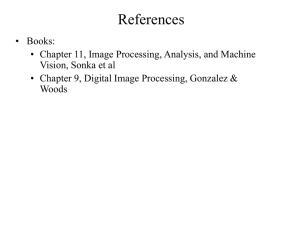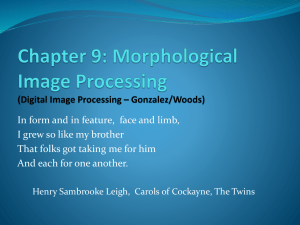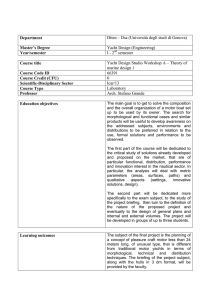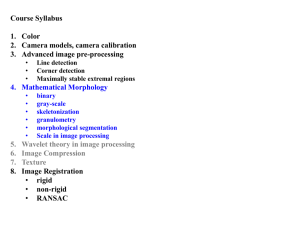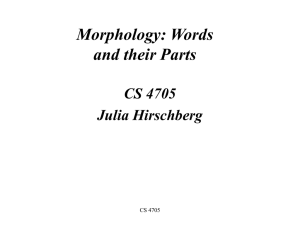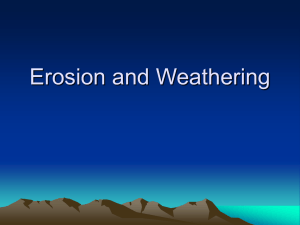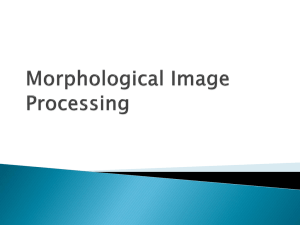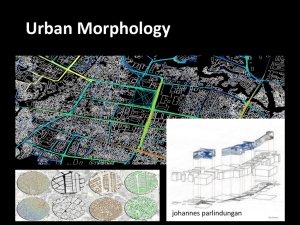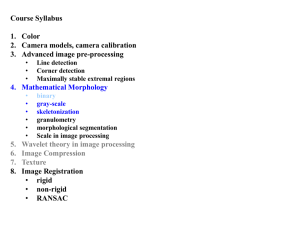Document
advertisement
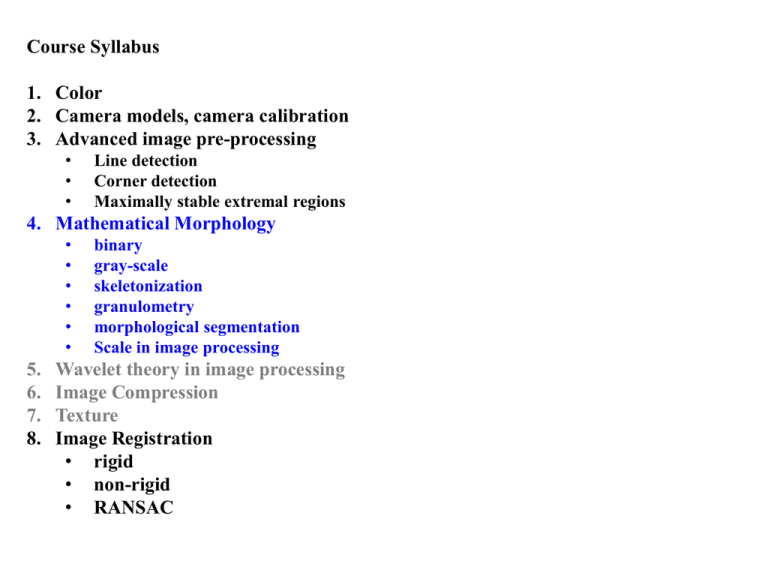
Course Syllabus
1. Color
2. Camera models, camera calibration
3. Advanced image pre-processing
•
•
•
Line detection
Corner detection
Maximally stable extremal regions
4. Mathematical Morphology
•
•
•
•
•
•
5.
6.
7.
8.
binary
gray-scale
skeletonization
granulometry
morphological segmentation
Scale in image processing
Wavelet theory in image processing
Image Compression
Texture
Image Registration
• rigid
• non-rigid
• RANSAC
References
• Books:
• Chapter 11, Image Processing, Analysis, and Machine
Vision, Sonka et al
• Chapter 9, Digital Image Processing, Gonzalez &
Woods
Topics
1. Basic Morphological concepts
2. Binary Morphological operations
•
•
•
Dilation & erosion
Hit-or-miss transformation
Opening & closing
3. Gray scale morphological operations
4. Some basic morphological operations
•
•
•
•
Boundary extraction
Region filling
Extraction of connected component
Convex hull
5. Skeletonization
6. Granularity
7. Morphological segmentation and watersheds
Introduction
1. Morphological operators often take a binary image and a
structuring element as input and combine them using a set
operator (intersection, union, inclusion, complement).
binary
image
2. The structuring element is shifted over the image and at each
pixel of the image its elements are compared with the set of
the underlying pixels.
3. If the two sets of elements match the condition defined by the
set operator (e.g. if set of pixels in the structuring element is a
subset of the underlying image pixels), the pixel underneath
the origin of the structuring element is set to a pre-defined
value (0 or 1 for binary images).
4. A morphological operator is therefore defined by its
structuring element and the applied set operator.
5. Image pre-processing (noise filtering, shape simplification)
6. Enhancing object structures (skeletonization, thinning, convex
hull, object marking)
7. Segmentation of the object from background
8. Quantitative descriptors of objects (area, perimeter, projection,
Euler-Poincaré characteristics)
structuring
element
Example: Morphological Operation
• Let ‘⊕’ denote a morphological operator
𝑋 ⊕ 𝐵 = {𝑝 ∈ 𝑍 2 |𝑝 = 𝑥 + 𝑏, 𝑥 ∈ 𝑋, 𝑏 ∈ 𝐵
Dilation
•
Morphological dilation ‘⊕’ combines two sets using vector of set elements
𝑋 ⊕ 𝐵 = {𝑝 ∈ 𝑍 2 |𝑝 = 𝑥 + 𝑏, 𝑥 ∈ 𝑋, 𝑏 ∈ 𝐵
Commutative:
Associative:
𝑋⊕𝐵 =𝐵⊕𝑋
𝑋⊕ 𝐵⊕𝐷 = 𝑋⊕𝐵 ⊕𝐷
Invariant of translation:
𝑋ℎ ⊕ 𝐵 = 𝑋 ⊕ 𝐵
ℎ
If 𝑋 ⊆ 𝑌 then 𝑋 ⊕ 𝐵 ⊆ 𝑌 ⊕ 𝐵
Erosion
1. Morphological erosion ‘⊖’ combines two sets using vector subtraction of set elements
and is a dual operator of dilation
𝑋 ⊖ 𝐵 = {𝑝 ∈ 𝑍 2 |∀𝑏 ∈ 𝐵, 𝑝 + 𝑏 ∈ 𝑋
!
𝑋⊖𝐵 ≠𝐵⊖𝑋
Not Commutative:
Not associative:
𝑋⊖ 𝐵⊖𝐷 = 𝑋⊖𝐵 ⊖𝐷
Invariant of translation:
𝑋ℎ ⊖ 𝐵 = 𝑋 ⊖ 𝐵
ℎ
and
𝑋 ⊖ 𝐵ℎ = 𝑋 ⊖ 𝐵
If 𝑋 ⊆ 𝑌 then 𝑋 ⊖ 𝐵 ⊆ 𝑌 ⊖ 𝐵
−ℎ
Duality: Dilation and Erosion
•
Transpose Ă of a structuring element A is defined as follows
𝐴 = {−𝑎|𝑎 ∈ 𝐴
• Duality between morphological dilation and erosion operators
𝑋⊖𝐵
𝑐
!
= 𝑋𝑐 ⊕ 𝐵
Hit-Or-Miss transformation
•
Hit-or-miss is a morphological operators for finding local patterns of pixels. Unlike
dilation and erosion, this operation is defined using a composite structuring element 𝐵 =
𝐵1 , 𝐵2 . The hit-or-miss operator is defined as follows
𝑋 ⊗ 𝐵 = {𝑥|𝐵1 ⊂ 𝑋 and 𝐵2 ⊂ 𝑋 𝒄
Hit-Or-Miss transformation: another example
Relation with erosion:
𝑋 ⊗ 𝐵 = 𝑋 ⊖ 𝐵1 ∩ 𝑋 𝑐 ⊖ 𝐵2
Hit-Or-Miss transformation: yet another example
Opening
•
Erosion and dilation are not inverse transforms. An erosion followed by a dilation leads
to an interesting morphological operation called opening
𝑋 ∘ 𝐵 = 𝑋 ⊖ 𝐵) ⊕ 𝐵
!
Opening
•
Erosion and dilation are not inverse transforms. An erosion followed by a dilation leads
to an interesting morphological operation called opening
𝑋 ∘ 𝐵 = 𝑋 ⊖ 𝐵) ⊕ 𝐵
Opening
•
Erosion and dilation are not inverse transforms. An erosion followed by a dilation leads
to an interesting morphological operation called opening
𝑋 ∘ 𝐵 = 𝑋 ⊖ 𝐵) ⊕ 𝐵
Opening
•
Erosion and dilation are not inverse transforms. An erosion followed by a dilation leads
to an interesting morphological operation called opening
𝑋 ∘ 𝐵 = 𝑋 ⊖ 𝐵) ⊕ 𝐵
Closing
•
A dilation followed by an erosion leads to the interesting morphological operation called
closing
𝑋 • 𝐵 = 𝑋 ⊕ 𝐵) ⊖ 𝐵
Closing
•
A dilation followed by an erosion leads to the interesting morphological operation called
closing
𝑋 • 𝐵 = 𝑋 ⊕ 𝐵) ⊖ 𝐵
!
Closing
•
A dilation followed by an erosion leads to the interesting morphological operation called
closing
𝑋 • 𝐵 = 𝑋 ⊕ 𝐵) ⊖ 𝐵
Gray Scale Morphological Operation
y f ( x1, x2 )
top surface
T[A]
Set A
x1
Support F
x2
Gray Scale Morphological Operation
• A: a subset of n-dimensional Euclidean space, A Rn
• F: support of A
F {x R n 1 | y R s.t. ( x, y ) A}
• Top hat or surface T ( A) : F R n
T ( A)( x) max{ y | ( x, y) A}
• A top surface is essentially a gray scale image f : F R
• An umbra U(f) of a gray scale image f : F R is the whole
subspace below the top surface representing the gray scale
image f. Thus,
U ( f ) {( x, y) F R, y f ( x)}
Gray Scale Morphological Operation
y f ( x1, x2 )
top surface
T[A]
x1
x2
Gray Scale Morphological Operation
• The gray scale dilation between two functions may be defined as the
top surface of the dilation of their umbras
f k T (U ( f ) U (k ))
• More computation-friendly definitions
f k max{ f ( x z ) k ( z )}
zk
f k min{ f ( x z ) k ( z )}
zk
• Commonly, we consider the structure element k as a binary set. Then
the definitions of gray-scale morphological operations simplifies to
f k max{ f ( x z )}
zk
f k min{ f ( x z )}
zk
Morphological Boundary Extraction
• The boundary of an object A denoted by δ(A) can be obtained by first
eroding the object and then subtracting the eroded image from the
original image.
( A) A AB
Quiz
• How to extract edges along a given orientation using morphological
operations?
Morphological noise filtering
• An opening followed by a closing
• Or, a closing followed by an opening
( X B) B
( X B) B
Morphological noise filtering
MATLAB DEMO
Morphological Region Filling
• Task: Given a binary image X and a (seed) point p, fill the region
surrounded by the pixels of X and contains p.
• A: An image where only the boundary pixels are labeled 1 and others
are labeled 0
• Ac: The Complement of A
• We start with an image X0 where only the seed point p is 1 and others
are 0. Then we repeat the following steps until it converges
X k ( X k 1 B) Ac
k 1, 2,3,...
Morphological Region Filling
Ac
A
Morphological Region Filling
• The boundary of an object A denoted by δ(A) can be obtained by first
eroding the object and then subtracting the eroded image from the
original image.
A
( A) A AB
Morphological Region Filling
X k ( X k 1 B) ( A)c
k 1, 2,3,...
Morphological Region Filling
Homotopic Transformation
• Homotopic tree
r1
h2
h1
r2
Quitz: Homotopic Transformation
• What is the relation between an element in the ith and i+1th levels?
Skeletonization
• Skeleton by maximal balls: locii of the centers of maximal balls
completely included by the object
S ( X ) {c X : r 0, B ( p, r ) closure( X )
and r r , B ( p, r ) closure( X )
Skeletonization
• Matlab Demo
• HW: Write an algorithm using morphologic operators to retrieve back
the portions of the GOOD curves lost during pruning
Skeletonization and Pruning
• Skeletonization preserves both
• End points
• Topology
• Pruning preserves only
• Topology
after
skeletonization
after pruning
after retrieval
Quench function
• Every location p on the skeleton S(X) of a shape X has an associated
radius qX(p) of maximal ball; this function is termed as quench
function
• The set X is recoverable from its skeleton and its quench function
X
p B( p, q X ( p))
pS ( X )
Ultimate Erosion
• The ultimate erosion of a set X, denoted by Ult(X), is the set of
regional maxima of the quench functions
• Morphological reconstruction: Assume two sets A, B such that B A.
The reconstruction σA(B) of the set A is the unions of all connected
components of A with nonempty intersection with B.
B
A
Ultimate Erosion
• The ultimate erosion of a set X, denoted by Ult(X), is the set of
regional maxima of the quench functions
• Morphological reconstruction: Assume two sets A, B such that B A.
The reconstruction σA(B) of the set A is the unions of all connected
components of A with nonempty intersection with B.
X B(n) X B ( n ) ( X B(n 1))
Ult ( X )
nZ
Convex Hull
• A set A is said to be convex if the straight line joining any two points
within A lies in A.
• Q: Is an empty set convex?
• Q: What ar4e the topological properties of a convex set?
• A convex hull H of a set X is the minimum convex set containing X.
• The set difference H – X is called the convex deficiency of X.
X ki ( X k 1 Bi ) A | i 1, 2,3, 4 and k 1, 2,...
X0 A
and X k X k1
X k2
X k3
X k4
Geodesic Morphological Operations
• The geodesic distance DX(x,y) between two points x and y w.r.t. a set
X is the length of the shortest path between x and y that entirely lies
within X.
??
Geodesic Balls
• The geodesic ball BX(p,n) of center p and radius n w.r.t. a set X is a
ball constrained by X.
BX ( p, n) { p X , d X ( p, p) n}
Geodesic Operations
• The geodesic dilation δX(n)(Y) of the set Y by a geodesic ball of radius
n w.r.t. a set X is :
(n)
X (Y )
BX ( p, n)
pY
• The geodesic erosion εX(n)(Y) of the set Y by a geodesic ball of radius
n w.r.t. a set X is :
X( n ) (Y ) { p Y | BX ( p, n) Y }
An example
• What happens if we apply geodesic erosion on X – {p}
where p is a point in X?
Implementation Issue
r1 r2 B(r1 ) Ø B(r2 )
• An efficient solution: select a ball of radius ‘1’ and then
define
X(1) (Y B) X
X( n ) X(1) ( X(1) ( X(1) (...)))
n times
Morphological Reconstruction
• Assume that we want to reconstruct objects of a given shape from a
binary image that was originally obtained by thresholding. All
connected components in the input image constitute the set X.
However, we are interested only a few connected components marked
by a marker set Y.
How?
• Successive geodesic dilations of the set Y inside the bigger set X leads
to the reconstruction of connected components of X marked by Y.
• The geodesic dilation terminates when all connected components of X
marked by Y are filled, i.e., an idempotency is reached :
n n0 , X( n ) (Y ) X( n0 ) (Y )
• This operation is called reconstruction and is denoted by ρX(Y).
X (Y ) lim X( n ) (Y )
n
Geodesic Influence Zone
• Let Y, Y1, Y2, ..Ym denote m marker sets on a bigger set X such that each
of Y and Yis is a subset of X.
X (Y , Y1 , Y2 , Ym ) lim X( n ) (Y ) X( n ) (Y1 ) X( n ) (Y2 )
n
X( n ) (Ym )
Reconstruction to Gray-Scale Images
• This requires the extension of geodesy to gray-scale images.
• Any increasing transformation defined for binary images can be extended
to gray-level images
X , Y Z
2
and Y X (Y ) ( X )
• A gray level image I is viewed as a stack of binary images obtained by
successive thresholding – this process is called threshold decomposition
Tk ( I ) { p DI , I ( p ) k} k 0,
,N
• Threshold decomposition principle
p DI , ( I )( p ) max{k [0,1,..., N ], p B (Tk ( I ))}
Reconstruction to Gray-Scale Images
• Returning to the reconstruction transformation, binary geodesic
reconstruction ρ is an increasing transformation
Y1 Y2 , X 1 X 2 , Y1 X 1 , Y2 X 2 X1 (Y1 ) X 2 (Y2 )
• Gray-scale reconstruction: Let J, I be two gray-scale images both over
the domain D such that J I, the gray-scale reconstruction ρI(J) of the
image I from J is defined as
p D, I ( J )( p) max{k [0, N ], p Tk (i ) (Tk ( j ))}
Reconstruction to Gray-Scale Images
I
I ( J )
J
